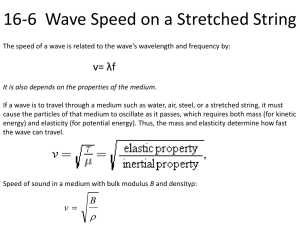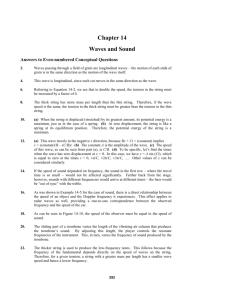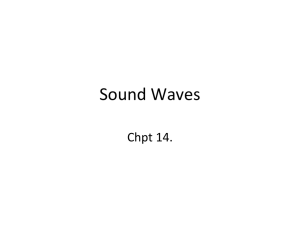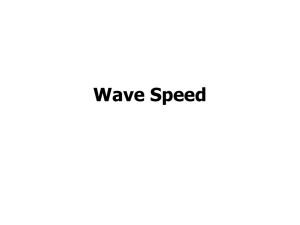hw12
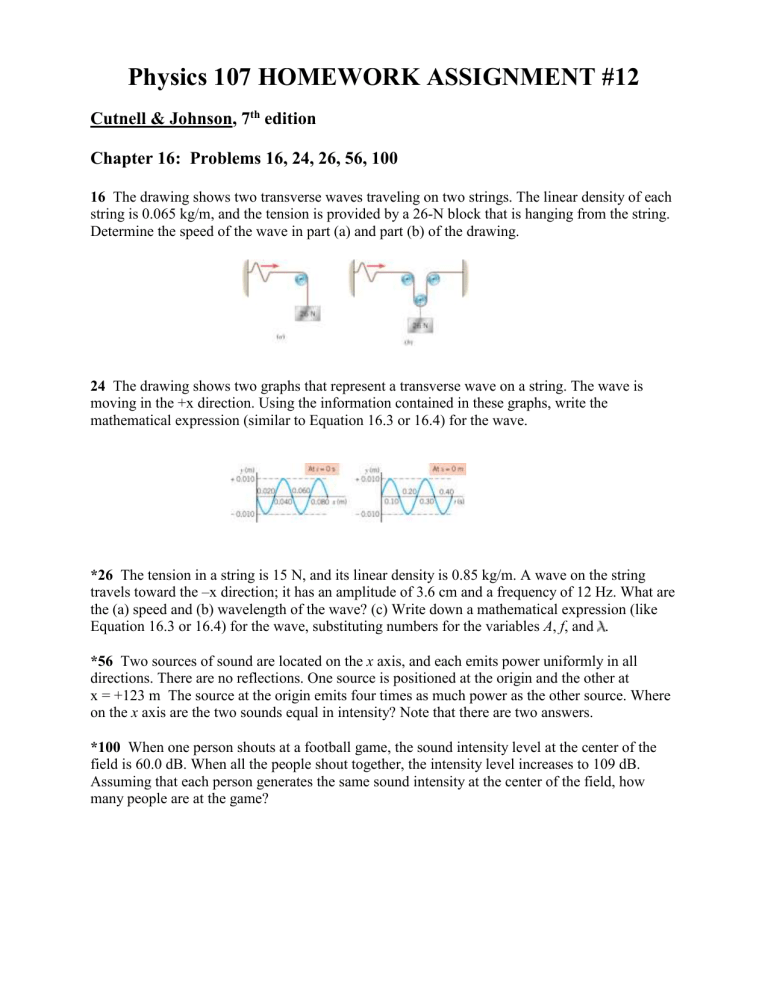
Physics 107 HOMEWORK ASSIGNMENT #12
Cutnell & Johnson, 7 th edition
Chapter 16: Problems 16, 24, 26, 56, 100
16 The drawing shows two transverse waves traveling on two strings. The linear density of each string is 0.065 kg/m, and the tension is provided by a 26-N block that is hanging from the string.
Determine the speed of the wave in part (a) and part (b) of the drawing.
24 The drawing shows two graphs that represent a transverse wave on a string. The wave is moving in the +x direction. Using the information contained in these graphs, write the mathematical expression (similar to Equation 16.3 or 16.4) for the wave.
*26 The tension in a string is 15 N, and its linear density is 0.85 kg/m. A wave on the string travels toward the –x direction; it has an amplitude of 3.6 cm and a frequency of 12 Hz. What are the (a) speed and (b) wavelength of the wave? (c) Write down a mathematical expression (like
Equation 16.3 or 16.4) for the wave, substituting numbers for the variables A , f , and .
*56 Two sources of sound are located on the x axis, and each emits power uniformly in all directions. There are no reflections. One source is positioned at the origin and the other at x = +123 m The source at the origin emits four times as much power as the other source. Where on the x axis are the two sounds equal in intensity? Note that there are two answers.
*100 When one person shouts at a football game, the sound intensity level at the center of the field is 60.0 dB. When all the people shout together, the intensity level increases to 109 dB.
Assuming that each person generates the same sound intensity at the center of the field, how many people are at the game?
16. REASONING The speed v of a transverse wave on a string is given by v
F /
/
(Equation 16.2), where F is the tension and m / L is the mass per unit length (or linear density) of the string. The strings are identical, so they have the same mass per unit length. However, the tensions are different. In part (a) of the text drawing, the string supports the entire weight of the 26-N block, so the tension in the string is 26 N. In part (b), the block is supported by the part of the string on the left side of the middle pulley and the part of the string on the right side. Each part supports one-half of the block’s weight, or 13 N. Thus, the tension in the string is 13 N.
SOLUTION a. The speed of the transverse wave in part (a) of the text drawing is v
F
26 N
2.0 10 m/s
0.065 kg/m b. The speed of the transverse wave in part (b) of the drawing is v
F
13 N
0.065 kg/m
1.4 10 m/s
24.
REASONING AND SOLUTION We find from the graph on the left that = 0.060 m –
0.020 m = 0.040 m and = 0.010 m. From the graph on the right we find that = 0.30 s –
0.10 s = 0.20 s. Then, f = 1/(0.20 s) = 5.0 Hz. Substituting these into Equation 16.3 we get y
A
f t
–
2
x
and y
t
– 50 x
26.
REASONING The speed of a wave on the string is given by Equation 16.2 as v
F
, where F is the tension in the string and m / L is the mass per unit length (or linear density) of the string. The wavelength is the speed of the wave divided by its frequency f
(Equation 16.1).
SOLUTION a. The speed of the wave on the string is v
F
15 N
0.85 kg/m
4.2 m/s b. The wavelength is
v
f
4.2 m/s
12 Hz
0.35 m
c. The amplitude of the wave is A = 3.6 cm = 3.6 10
2 m. Since the wave is moving along the x direction, the mathematical expression for the wave is given by Equation 16.4 as y
A
sin 2
f t
2
x
Substituting in the numbers for A , f , and , we have y
A
sin 2
f t
2
x
2
12 Hz
t
2
x
0.35 m
2
75 s
1
18 m
1
x
56.
REASONING Equation 16.9 gives the
I intensity I (the power per unit area) as
= P /(4 r
2
) for uniformly radiating sources. The drawing at the right shows the two
x
123 m sound sources and the point where the intensity of each sound is the same; this point is located
Source 1 Source 2 a distance x from the origin. We will apply Equation 16.9 to each source and set the two intensities equal. The resulting quadratic expression will allow us to find the two values for x .
SOLUTION Using P
1
and P
2
to denote the power emitted by source 1 and source 2 and applying Equation 16.9, we have
2
4
P
1 x
2
P
2 x
2 or
P
1
P
2
x
123 m – x
4
Intensity of sound 1
Intensity of sound 2 where we have used the fact that P
1 roots of the equation on the right gives
= 4 P
2
. Taking both the positive and negative square
Positive root Negative root x
123 m – x
2 x
x
x
82.0 m x
123 m – x
–2 x
x
x
246 m
100. REASONING If I
1
is the sound intensity produced by a single person, then N I
1
is the sound intensity generated by N people. The sound intensity level generated by N people is given by Equation 16.10 as
N
N I
1
I
0 where I
0
is the threshold of hearing. Solving this equation for N yields
N
I
0
10
I
1
N
10 dB
We also know that the sound intensity level for one person is
1
I
I
0 or I
1
I
0
1
10
10 dB
(1)
(2)
Equations (1) and (2) are all that we need in order to find the number of people at the football game.
SOLUTION Substituting the expression for I
1 the desired result.
from Equation (2) into Equation (1) gives
N
109 dB
I
0
10
10 dB 10 dB
N
1
10
60.0 dB
79 400
10
10 dB
10
10 dB
I
0
__________________________________________________________



